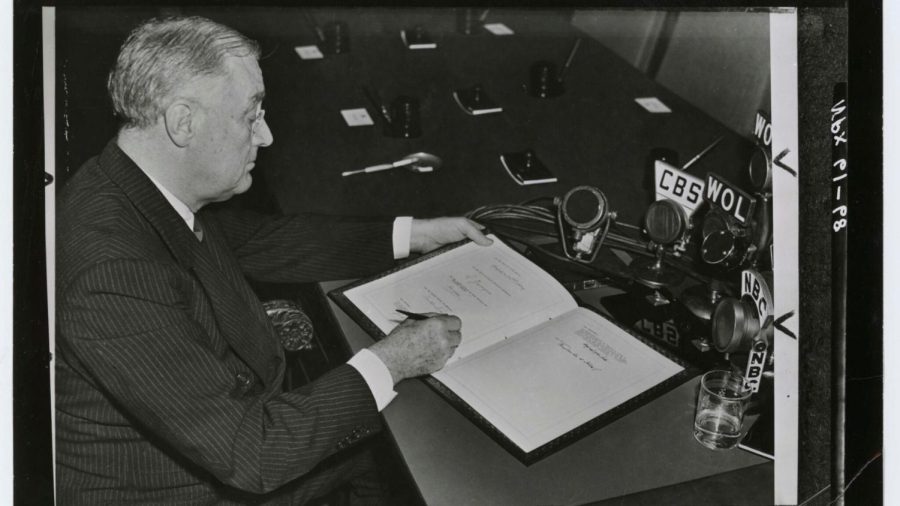Shattering another excuse for FDR’s Holocaust apathy
U.S. President Franklin D. Roosevelt in Washington, D.C., Nov. 9, 1943. Credit: National Archives and Records Administration.
Published May 9, 2023
A recent New York Times feature about a troubled World War II veteran has inadvertently shed fresh light on the Roosevelt administration’s refusal to bomb the railways leading to Auschwitz. The story also implicitly undermines one of the major themes of the recent Ken Burns documentary about America’s response to the Nazi genocide.
According to the Times, Brooklyn resident John Wenzel, who will soon celebrate his 100th birthday, had never wanted to discuss his wartime service. But recently he began suffering nightmares about it, prompting him and his daughters to examine a long-unopened box of letters that he wrote to his family during his time in Europe.
Wenzel was a fighter pilot who flew bombing missions over German-occupied northern Italy and southern Austria in early 1945. His targets, the Times article noted, included “Axis railroad cars,” “a rail line,” and “stalled enemy train cars.” He was wounded—and subsequently awarded two Purple Hearts—while providing air support for soldiers “pushing toward a rail hub.”
Here’s how Wenzel’s story intersects with the Holocaust. Contemporary defenders of President Franklin D. Roosevelt’s Holocaust record argue that there was no point in bombing the railways to Auschwitz—over which hundreds of thousands of Jews were deported to their deaths—because the Germans sometimes were able to repair railway lines fairly quickly. Ken Burns promoted that claim in his recent film, “The U.S. and the Holocaust.”
The reality, however, is that the Allies constantly bombed railway lines throughout Europe, despite the possibility of the Germans repairing them.
Bombing railways, including the bridges along their routes, consumed no less than 32% of the bomb tonnage utilized in the Allies’ entire strategic air campaign in Europe. John Wenzel was just one of more than 165,000 American pilots who graduated basic flight training in World War II. Yet the bombing of Axis railway targets in Europe was so common that when the New York Times picked one pilot’s story to spotlight, sure enough he was among those involved in the railway attacks.
ADVERTISEMENT
When the Allies began preparing to invade Italy in 1943, they carried out extensive bombing of enemy transportation routes there. Likewise, during the months before the crucial D-Day landings in 1944, American and British pilots attacked railway targets across France, Belgium, and western Germany. By D-Day, France’s railways were functioning at just 10% of their normal capacity.
The impact of these raids was felt in many ways. The Germans were forced to divert tens of thousands of laborers from military construction in order to repair damaged railroads. Trains carrying army supplies were stranded for long periods of time, and some war materials remained in warehouses for lack of transportation to the front. Hitler’s Ardennes offensive (the Battle of the Bulge) was repeatedly postponed because damage to transportation routes prevented resupplying German troops there. Air strikes on rail marshaling yards destroyed freight cars, locomotives, and military goods awaiting shipment.
As a result, many German army units went into battle without adequate equipment or personnel. Of the 2,100 tanks manufactured by German factories in the autumn of 1944, less than half reached German forces. The quality of their weaponry also was affected, because disruptions to the rail lines interfered with testing and modifying armaments. Army morale was affected, too; military leaves for many German soldiers were suspended for lack of trains.
The pre-D-Day focus on railways was so successful that the Allies decided to move transportation systems up to second on their priority list in the strategic bombing campaign in 1944. These massive Allied air attacks on railways and related targets were taking place at the same time that Jewish leaders were pleading for the bombing of the railways and bridges leading to Auschwitz.
Later that year, Allied air attacks targeted and destroyed 20 rail centers, 113 bridges, and 28,000 railroad cars in German’s Ruhr region, its major source of coal. The result was a reduction in coal production by two-thirds, and a significant depletion of coal stockpiles—a major blow to the German war effort. The ripple effects included shutdowns in various other industries. The Strategic Bombing Survey, an internal analysis conducted by U.S. government experts, concluded that the targeting of transportation routes in Ruhr and elsewhere in 1944 “was the most important single cause of Germany’s ultimate economic collapse.”
Yet when American Jewish organizations asked the Roosevelt administration to bomb a few specific railway lines and bridges leading to Auschwitz, U.S. officials claimed that would be an unjustified “diversion” from the war effort—even though German troops and war material traveled on those same routes, in addition to the deported Jews.
Was the administration’s refusal based on the possibility that the Germans might try to repair the railways? Obviously not. The refusal was rooted in the Roosevelt administration’s view that military resources should never be used to assist Jewish refugees, even if it involved nothing more than targeting a handful of railways and bridges—at the very moment that Allied pilots were constantly being sent to bomb so many other railways, as the New York Times feature on John Wenzel reminds us.














